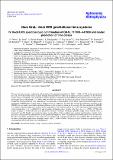Files in this item
Gaia GraL: Gaia DR2 gravitational lens systems : IV. Keck/LRIS spectroscopic confirmation of GRAL 113100-441959 and model prediction of time delays
Item metadata
| dc.contributor.author | Wertz, O. | |
| dc.contributor.author | Stern, D. | |
| dc.contributor.author | Krone-Martins, A. | |
| dc.contributor.author | Delchambre, L. | |
| dc.contributor.author | Ducourant, C. | |
| dc.contributor.author | Gråe Jørgensen, U. | |
| dc.contributor.author | Dominik, M. | |
| dc.contributor.author | Burgdorf, M. | |
| dc.contributor.author | Surdej, J. | |
| dc.contributor.author | Mignard, F. | |
| dc.contributor.author | Teixeira, R. | |
| dc.contributor.author | Galluccio, L. | |
| dc.contributor.author | Klüter, J. | |
| dc.contributor.author | Djorgovski, S. G. | |
| dc.contributor.author | Graham, M. J. | |
| dc.contributor.author | Bastian, U. | |
| dc.contributor.author | Wambsganss, J. | |
| dc.contributor.author | Boehm, C. | |
| dc.contributor.author | LeCampion, J.-F. | |
| dc.contributor.author | Slezak, E. | |
| dc.date.accessioned | 2019-09-09T14:30:05Z | |
| dc.date.available | 2019-09-09T14:30:05Z | |
| dc.date.issued | 2019-08 | |
| dc.identifier | 261010602 | |
| dc.identifier | a0c2fd5a-353b-4500-b0a5-7f8451081bcd | |
| dc.identifier | 85070201346 | |
| dc.identifier | 000477695700003 | |
| dc.identifier.citation | Wertz , O , Stern , D , Krone-Martins , A , Delchambre , L , Ducourant , C , Gråe Jørgensen , U , Dominik , M , Burgdorf , M , Surdej , J , Mignard , F , Teixeira , R , Galluccio , L , Klüter , J , Djorgovski , S G , Graham , M J , Bastian , U , Wambsganss , J , Boehm , C , LeCampion , J-F & Slezak , E 2019 , ' Gaia GraL: Gaia DR2 gravitational lens systems : IV. Keck/LRIS spectroscopic confirmation of GRAL 113100-441959 and model prediction of time delays ' , Astronomy & Astrophysics , vol. 628 , A17 . https://doi.org/10.1051/0004-6361/201834573 | en |
| dc.identifier.issn | 0004-6361 | |
| dc.identifier.other | BibCode: 2019A&A...628A..17W | |
| dc.identifier.other | ORCID: /0000-0002-3202-0343/work/75996671 | |
| dc.identifier.uri | https://hdl.handle.net/10023/18440 | |
| dc.description.abstract | We report the spectroscopic confirmation and modeling of the quadruply imaged quasar GRAL 113100-441959, the first gravitational lens (GL) to be discovered from a machine learning technique that only relies on the relative positions and fluxes of the observed images without considering colour informations. Follow-up spectra obtained with Keck/LRIS revea lthe lensing nature of this quadruply imaged quasar with redshift zs = 1.090 ± 0.002, but show no evidence of the central lens galaxy. Using the image positions and G-band flux ratios provided by Gaia Data Release 2 as constraints, we modeled the system with a singular power-law elliptical mass distribution (SPEMD) plus external shear, to different levels of complexity. We show that relaxing the isothermal constraint of the SPEMD does not lead to statistically significant different results in terms of fitting the lensing data. We thus simplified the SPEMD to a singular isothermal ellipsoid to estimate the Einstein radius of the main lens galaxy θE =0.″851, the intensity and position angle of the external shear(γ,θγ) = (0.044, 11.°5), and we predict the lensing galaxy position to be (θgal,1,θgal,2) = (-0.″424, -0.″744) with respect to image A. We provide time delay predictions for pairs of images, assuming a plausible range of lens redshift values zl between 0.5 and 0.9. Finally, we examine the impact on time delays of the so-called source position transformation, a family of degeneracies existing between different mass density profiles that reproduce most of the lensing observables equally well. We show that this effect contributes significantly to the time delay error budget and cannot be ignored during the modeling. This has implications for robust cosmography applications of lensed systems. GRAL 113100-441959 is the first in a series of seven new spectroscopically confirmed GLs discovered from Gaia Data Release 2. | |
| dc.format.extent | 9 | |
| dc.format.extent | 5653825 | |
| dc.language.iso | eng | |
| dc.relation.ispartof | Astronomy & Astrophysics | en |
| dc.subject | Gravitational lensing: strong | en |
| dc.subject | Quasars: general | en |
| dc.subject | Astrometry | en |
| dc.subject | QB Astronomy | en |
| dc.subject | QC Physics | en |
| dc.subject | NDAS | en |
| dc.subject.lcc | QB | en |
| dc.subject.lcc | QC | en |
| dc.title | Gaia GraL: Gaia DR2 gravitational lens systems : IV. Keck/LRIS spectroscopic confirmation of GRAL 113100-441959 and model prediction of time delays | en |
| dc.type | Journal article | en |
| dc.contributor.institution | University of St Andrews. School of Physics and Astronomy | en |
| dc.contributor.institution | University of St Andrews. St Andrews Centre for Exoplanet Science | en |
| dc.identifier.doi | 10.1051/0004-6361/201834573 | |
| dc.description.status | Peer reviewed | en |
| dc.identifier.url | http://adsabs.harvard.edu/abs/2019A%26A...628A..17W | en |
This item appears in the following Collection(s)
Items in the St Andrews Research Repository are protected by copyright, with all rights reserved, unless otherwise indicated.

